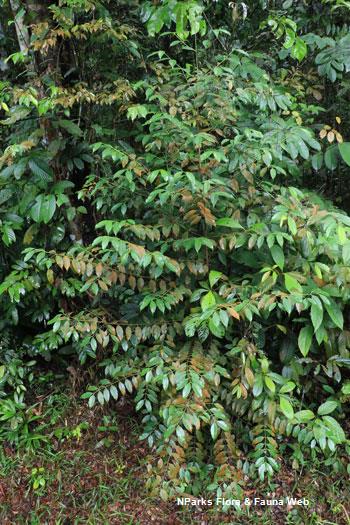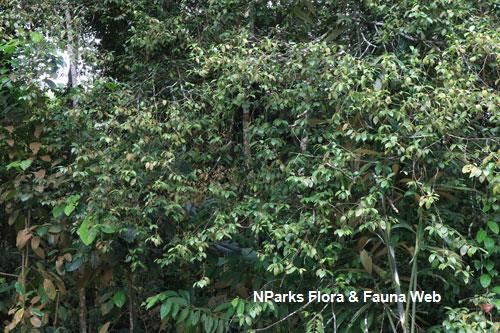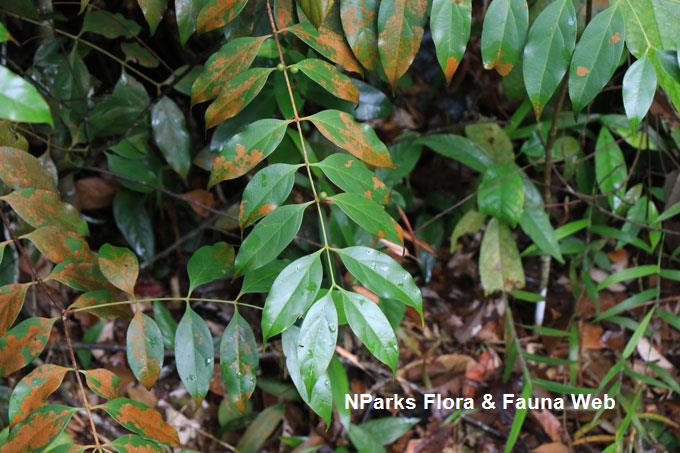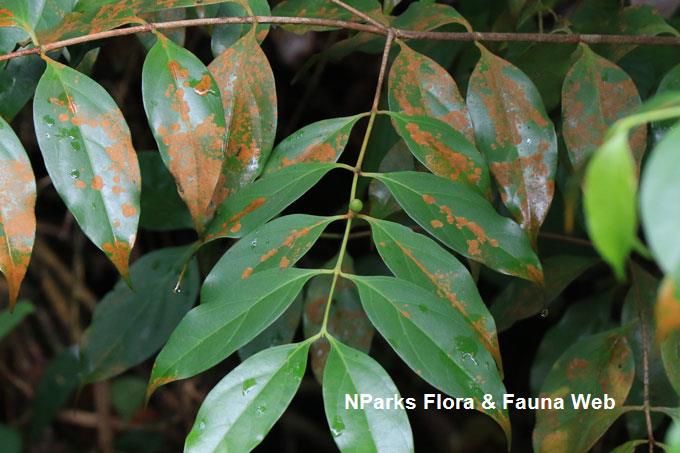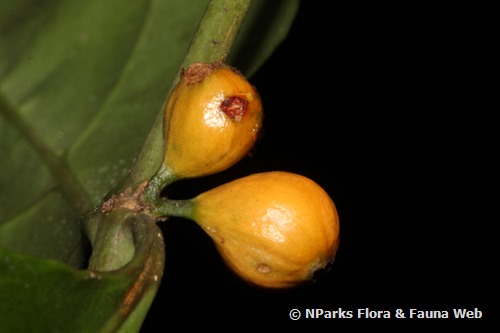
Back
Dibridsonia conferta (Korth.) K.M.Wong
| Family Name: | Rubiaceae |
| Synonyms: | Canthium confertum Korth. |
| Common Name: | Green Coffee, Kahwa Utan, Kemuning Jantan Hutan, Kopi Utan, Mata Keli Jantan |
Dibridsonia conferta or Green Coffee is a medium-sized tree native to Singapore. Growing to 18 m tall, the leaves are slightly leathery and elliptic, held on a short petiole. Flowers are green, tubular held on an inflorescence. The lobes are curved backwards while the throat of the flower is covered in dense, pale, erect hairs. The fruit is an orange, tear-shaped drupe, consist of 1 tear-shaped pyrene covered in bumps.
Name
Classifications and Characteristics
| Plant Division | Angiosperms (Flowering Seed Plants) (Dicotyledon) |
|---|---|
| Plant Growth Form | Tree (Medium (16m-30m)) |
| Lifespan (in Singapore) | Perennial |
| Mode of Nutrition | Autotrophic |
| Plant Shape | Irregular |
| Maximum Height | 18 m |
Biogeography
| Native Distribution | Peninsular Thailand, Peninsular Malaysia, Sumatra, Borneo, Philippines, Singapore |
|---|---|
| Native Habitat | Terrestrial (Coastal Forest, Primary Rainforest, Secondary Rainforest) |
| Preferred Climate Zone | Tropical |
| Local Conservation Status | Native to Singapore (Endangered (EN)) |
Description and Ethnobotany
| Growth Form | It is a medium sized tree that can grow to 18 m tall. |
|---|---|
| Foliage | Leaves are slightly leathery, elliptic, measuring 3.5 - 12 cm long by 1.5 - 5.5 cm wide held on a short petiole of 5 - 10 mm long. The leaves have 3 -5 pairs of lateral veins, tiny pockets known as domatia can be found on the underside, near the base of the lateral veins. |
| Flowers | Flowers are dioecious where the female and male flowers are produced on the same tree, held on an inflorescence. The flowers are green, tubular, borne on the axils of branches. Lobes are curved backwards, the throat is covered in dense pale erect hairs. |
| Fruit | The fruit is an orange, tear-shaped drupe measuring to 10 mm long by 9 mm wide. Each fruit contains 1 pyrene (pit) which is tear-shaped with bumps on the surface measuring to 9.6 mm long by 5.5 mm wide. Each pyrene contains 1 seed. |
| Habitat | Occurs commonly in coastal areas and lowland forest. |
| Cultivation | Dibridsonia conferta is intolerant to salt sprays, can be propagated by seeds. |
Landscaping Features
| Landscaping | It is suitable for parks. |
|---|---|
| Desirable Plant Features | Ornamental Fruits |
| Landscape Uses | Parks & Gardens |
Fauna, Pollination and Dispersal
| Pollination Method(s) | Biotic (Fauna) |
|---|---|
| Seed or Spore Dispersal | Biotic (Fauna) |
Plant Care and Propagation
| Light Preference | Full Sun, Semi-Shade |
|---|---|
| Water Preference | Moderate Water |
| Plant Growth Rate | Moderate |
| Rootzone Tolerance | Moist Soils, Well-Drained Soils, Fertile Loamy Soils |
| Propagation Method | Seed |
Foliar
| Foliage Retention | Evergreen |
|---|---|
| Mature Foliage Colour(s) | Green |
| Mature Foliage Texture(s) | Leathery |
| Foliar Modification | Stipule |
| Foliar Type | Simple / Unifoliate |
| Foliar Arrangement Along Stem | Opposite |
| Foliar Attachment to Stem | Petiolate |
| Foliar Shape(s) | Non-Palm Foliage (Elliptical) |
| Foliar Venation | Pinnate / Net |
| Foliar Margin | Entire |
| Foliar Apex - Tip | Acuminate |
| Foliar Base | Cuneate |
Non - Foliar and Storage
| Stem Type & Modification | Woody |
|---|---|
| Root Type | Underground |
Floral (Angiosperm)
| Flower & Plant Sexuality | Unisexual Flowers , Dioecious |
| Flower Colour(s) | Green, Green - Light Green |
|---|
| Flower Grouping | Cluster / Inflorescence |
| Flower Location | Axillary |
| Flower Symmetry | Radial |
| Individual Flower Shape | Tubular |
| Flowering Habit | Polycarpic |
Fruit, Seed and Spore
| Mature Fruit Colour(s) | Orange |
|---|---|
| Fruit Classification | Simple Fruit |
| Fruit Type | Fleshy Fruit , Drupe |
References
| References | <1> Wong, K.M., et. al. (2019). Rubiaceae. Flora of Singapore, vol. 13, pp. 62-65. Singapore: Singapore Botanic Gardens, National Parks Board. |
|---|
Image Repository
Others
| Master ID | 29472 |
|---|---|
| Species ID | 3781 |
| Flora Disclaimer | The information in this website has been compiled from reliable sources, such as reference works on medicinal plants. It is not a substitute for medical advice or treatment and NParks does not purport to provide any medical advice. Readers should always consult his/her physician before using or consuming a plant for medicinal purposes. |

